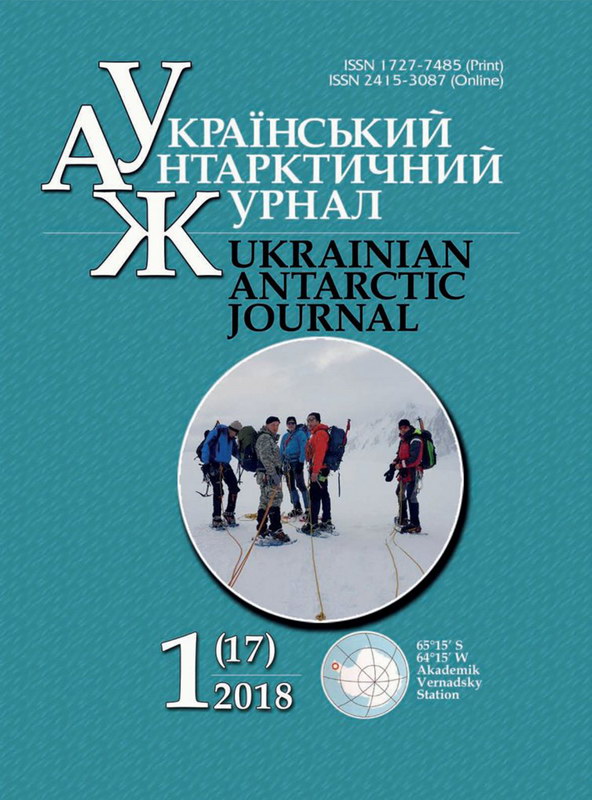Загальний вміст озону над антарктичною станцією «Академік Вернадський»: наземні та супутникові вимірювання
- загальний вміст озону,
- антарктична станція «Академік Вернадський»,
- спектрофотометр Добсона,
- супутникові вимірювання,
- порівняння даних

Ця робота ліцензується відповідно до Creative Commons Attribution-NonCommercial-NoDerivatives 4.0 International License.
Анотація
Мета. Проаналізувати зміни загального вмісту озону над антарктичною станцією «Академік Вернадський» (до 1996 р. станція Фарадей) за довгостроковими наземними та супутниковими рядами даних. Дослідити розбіжності між даними різних інструментів. Методи. Візуалізація даних з подальшим аналізом та статистичною обробкою рядів загального вмісту озону за вимірюваннями на спектрофотометрі Добсона на станції «Академік Вернадський» та супутниковими інструментами OMI, GOME2a, GOME2b та SCIAMACHY. Результати. Супутникові та наземні вимірювання загального вмісту озону в стратосфері над станцією «Академік Вернадський» підтвердили стабілізацію озонового шару з початку 2000-х років. Британські спостереження на станції Фарадей продемонстрували, що максимум загального вмісту озону протягом 1950–1970 рр. спостерігався навесні, аналогічно північній півкулі, а різке зниження загального вмісту озону протягом серпня–жовтня 1980–1990 рр. суттєво змінило загальний сезонний озоновий цикл і є наслідком впливу озонової діри. В даній роботі було проаналізовано супутникові та модельні дані на основі супутникових вимірювань. Було показано, що типові розбіжності між моделлю озонового моніторингу (OMI) та щоденними вимірюваннями на спектрофотометрі Добсона станції «Академік Вернадський» знаходяться в межах близько 20 DU. Великі відхилення зустрічаються рідко, і спостерігаються переважно на початку і в кінці спостережного сезону. Також були розраховані сезонні середні та стандартні відхилення відмінностей моделей від спостережень на спектрофотометрі Добсона, які свідчить про гіршу відповідність моделі ОМІ з даними спектрофотометра Добсона протягом окремих років, зокрема 2009–2010 років. Висновки. Як наземні, так і супутникові вимірювання загального вмісту озону в стратосфері над станцією Фарадей/«Академік Вернадський» продемонстрували загальне зменшення вмісту озону протягом 1980–1990 рр. навесні з подальшою стабілізацією починаючи з 2000-го року. Порівняння між наземними даними та моделями на основі супутникових вимірювань, свідчить про кращу відповідність результатів вимірювань на спектрофотометрі Добсона та GOME2 відносно порівняння з даними ОМІ. Визначено, що індивідуальні вимірювання на спектрофотометрі Добсона в деякій мірі недооцінюють загальний вміст озону на початку спостережного сезону, коли сонячні зенітні кути досить великі, а загальний вміст озону є низьким.
Посилання
- Basher, R. E. 1982. Review of the Dobson Spectrophotometer and its accuracy. Springer Netherlands, 387-391. https://doi.org/10.1007/978-94-009-5313-0_78
- Chipperfield, M. P., Bekki, S., Dhomse, S., Harris, N. R. P., Hassler, B., Hossaini, R., Steinbrecht, W., Thiéblemont, R., and Weber, M. 2017. Detecting recovery of the stratospheric ozone layer. Nature, 549(7671), 211. https://doi.org/10.1038/nature23681
- Chipperfield, M. P., Dhomse, S., Hossaini, R., Feng, W., Santee, M. L., Weber, M., Burrows, J. P., Wild, J. D., Loyola, D., Coldewey-Egbers, M. 2018. On the cause of recent variations in lower stratospheric ozone. Geophysical Research Letters, 45. https://doi.org/10.1029/2018GL078071
- Eskes, H. J., Van Velthoven, P. F. J., Valks, P. J. M., and Kelder, H. M. 2003. Assimilation of GOME total-ozone satellite observations in a three-dimensional tracer-transport model. Quarterly Journal of the Royal Meteorological Society, 129(590), 1663-1681. https://doi.org/10.1256/qj.02.14
- Farman, J. C., Gardiner, B. G., and Shanklin, J. D. 1985. Large losses of total ozone in Antarctica reveal seasonal clox/nox interaction. Nature, 315(6016), 207. https://doi.org/10.1038/315207a0
- Fioletov, V. E., Labow, G., Evans, R., Hare, E. W., Köhler, U., McElroy, C. T., Miyagawa, K., Redondas, A., Savastiouk, V., Shalamyansky, A. M., et al. 2008. Performance of the ground-based total ozone network assessed using satellite data. Journal of Geophysical Research: Atmospheres, 113(D14). https://doi.org/10.1029/2008JD009809
- Gottwald, M., H., Bovensmann, G., Lichtenberg, S., von Bargen S., N. A., Slijkhuis, A., Piters, R., von Savigny M., H. C., Buchwitz, A., Kokhanovsky, A., Richter, A., Rozanov, T., Holzer-Popp, K., J.-C., B., Lambert, J., Skupin, F., Schrijver, W. H., and Burrows, J. 2006. SCIAMACHY, monitoring the changing earth's atmosphere, German Aerospace Center (DLR), Remote Sensing Institute (IMF), Report No. 167.
- Grytsai, A. V., Evtushevsky, O. M., Agapitov, O. V., Klekociuk, A. R., and Milinevsky, G. P. 2007. Structure and long-term change in the zonal asymmetry in Antarctic total ozone during spring. Annales Geophysicae, 25(2), 361-374. https://doi.org/10.5194/angeo-25-361-2007
- Grytsai, A., Klekociuk, A., Milinevsky, G., Evtushevsky, O., and Stone, K. 2017. Evolution of the eastward shift in the quasi-stationary minimum of the Antarctic total ozone column. Atmospheric Chemistry and Physics, 17(3), 1741-1758. https://doi.org/10.5194/acp-17-1741-2017
- Grytsai, A. and Milinevsky, G. 2013. SCIAMACHY/Envisat, OMI/Aura, and ground-based total ozone measurements over Kyiv-Goloseyev station, International Journal of Remote Sensing, 34(15), 5611-5622. https://doi.org/10.1080/01431161.2013.794988.
- Ialongo, I., Sofieva, V., Kalakoski, N., Tamminen, J., and Kyroa, E. 2012. Ozone zonal asymmetry and planetary wave characterization during Antarctic spring. Atmospheric Chemistry and Physics, 12(5), 2603-2614. https://doi.org/10.5194/acp-12-2603-2012.
- Kravchenko, V., Evtushevsky, A., Grytsai, A., Milinevsky G., and Shanklin, J. 2009. Total ozone dependence of the difference between the empirically corrected EP-TOMS and high-latitude station datasets, International Journal of Remote Sensing, 30:15-16, 4283-4294, https://doi.org/10.1080/01431160902825008.
- Kuttippurath, J., Lefevre, F., Pommereau, J.-P., Roscoe, H. K., Goutail, F., Pazmino, A., and Shanklin, J. D. 2013. Antarctic ozone loss in 1979-2010: first sign of ozone recovery. Atmospheric Chemistry and Physics, 13(3), 1625-1635. https://doi.org/10.5194/acp-13-1625-2013.
- Redondas A., Evans R., Stuebi R., et al. 2014. Evaluation of the use of five laboratory-determined ozone absorption cross sections in Brewer and Dobson retrieval algorithms. Atmospheric Chemistry and Physics, 14, 1635-1648. https://doi.org/10.5194/acp-14-1635-2014
- Siddaway, J. M., Petelina, S. V., Karoly, D. J., Klekociuk, A. R., and Dargaville, R. J. 2013. Evolution of antarctic ozone in september-december predicted by ccmval-2 mo del simulations for the 21st century. Atmospheric Chemistry and Physics, 13(8), 4413-4427. https://doi.org/10.5194/acp-13-4413-2013
- Solomon, S. 1999. Stratospheric ozone depletion: A review of concepts and history. Reviews of Geophysics, 37(3), 275-316. https://doi.org/10.1029/1999RG900008.
- Stolarski, R. S., Krueger, A. J., Schoeberl, M. R., McPeters, R. D., Newman, P. A., and Alpert, J. C. 1986. Nimbus 7 satellite measurements of the springtime Antarctic ozone decrease. Nature, 322(6082), 808-811. https://doi.org/10.1038/322808a0.
- Veefkind, J. P., de Haan, J. F., Brinksma, E. J., Kroon, M., and Levelt, P. F. 2006. Total ozone from the ozone monitoring instrument (OMI) using the DOAS technique. IEEE Transactions on Geoscience and Remote Sensing, 44(5), 1239-1244. https://doi.org/10.1109/TGRS.2006.871204.
- Waugh, D. W. and Randel, W. J. 1999. Climatology of Arctic and Antarctic polar vortices using elliptical diagnostics. Journal of the Atmospheric Sciences, 56(11), 1594-1613. https://doi.org/10.1175/1520-0469(1999)056<1594:COAAAP>2.0.CO;2

